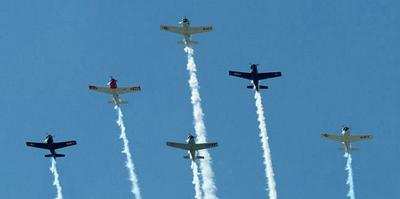T-28 Went Down During An Air Show, Board Says Pilot's Health Was Questionable
The FAA bears some responsibility for an accident that occurred during an air show in Martinsburg, WV in 2011, according to the NTSB's probable cause report.

According to the report, on September 17, 2011, about 1434 eastern daylight time, a North American T-28C, N688GR, registered to and operated by a private individual, collided with terrain during a low altitude aerobatic maneuver at the Eastern WV Regional Airport/Shepherd Field (MRB), Martinsburg, West Virginia. The pilot was fatally injured in the accident.
After takeoff for an airshow performance, the pilot, flying with the 'Trojan Horsemen' aerobatic team, performed maneuvers consisting of a barrel roll, loop, and an opposing pass with another airplane, culminating with an aileron roll. Witnesses and recorded video indicated that after the two airplanes crossed, the accident pilot began an aileron roll to the left, which degraded into a barrel roll. After completing about 270 degrees of the roll, the airplane stopped rolling and continued in a right-wing-down, nose-low attitude until impact. Review of the video revealed no separation of airplane parts and no obvious attempt by the pilot to recover. Postaccident examination of the airframe and flight controls and a cursory examination of the engine revealed no evidence of preimpact failure or malfunction that would have precluded normal operation.
According to the pilot's medical records, he developed early onset coronary artery disease and suffered a heart attack (myocardial infarction) at age 46, requiring urgent four-vessel coronary artery bypass graft (CABG) surgery in 2003. One of his grafts failed in the first year, and further intervention by surgery or angioplasty was deemed impossible. The pilot was aggressively treated for high cholesterol following his heart attack and also developed diabetes. Even with intensive treatment, atherosclerosis will predictably continue to develop. Thus, the risk of death and other major adverse cardiovascular events following CABG is significant and increases over time. Studies indicate that by 8 years following CABG surgery, approximately 30 percent of diabetic patients have died; this increases to nearly 40 percent by 12 years.
Following his surgery, the pilot applied for a special issuance of his medical certificate. During that process, he did not indicate that he intended to fly aerobatics. The pilot received a special issuance third class medical certificate, which was renewed annually. However, he was not asked again about the types of flying he was doing or intending to do. Although the pilot routinely passed regular exercise stress testing as part of the special issuance requirements, his personal medical records indicated that he had a small area of his heart muscle that was repeatedly identified as at risk on nuclear imaging studies.

The sudden changes in cardiac work associated with g-loading and unloading may be an independent risk factor for cardiac arrhythmia in the setting of a scar resulting from previous infarction. Even without g-loading, the risk of arrhythmia is highest in the first minutes, hours, and days after a heart attack. According to autopsy results, the medical examiner found a "fresh" area of myocardial infarction (heart attack) on the gross pathology; however, no microscopic analysis was performed. That the medical examiner was able to identify an area of grossly abnormal tissue suggests the event occurred hours to a couple of days previously. A closer approximation of the timing of the pilot's final myocardial infarction could not be determined.
The evidence indicates that the pilot likely became impaired or incapacitated while flying a low-altitude aerobatic maneuver soon after suffering a heart attack. The FAA knew about the pilot's medical condition and appropriate procedures had been followed during the evaluation for his aerobatic competency card. Currently, there are no limitations to permitted flight characteristics for special issuance medical certificates, including those issued for cardiac disease.

In January 1999, as a result of several investigations involving pilot incapacitation, including accidents during airshow performances, the NTSB issued Safety Recommendations A-99-1 and -2 asking the FAA to, respectively, "restrict all pilots with special issuance certificates due to cardiac conditions that could affect their g-tolerance from engaging in aerobatic flight" and "restrict all pilots taking medication that reduces g-tolerance from engaging in aerobatic flight." In evaluating these recommendations, FAA personnel reviewed an NTSB-supplied list of accidents using the following criteria: a) the accident must have occurred during aerobatic flight as defined by applicable FAA advisory circulars and regulations; b) the aerobatic maneuver must have been intentional; c) the aircraft must have been certified for aerobatic flight; d) the maneuver must have been authorized under FAA regulations; and e) the airman's cardiac or medication history must have been documented in his/her FAA medical record
at the time of the event. Based on the criteria, the FAA determined that the NTSB recommendations would "probably not have changed the outcome in any of the accidents." Further, the FAA indicated in its review that if there had been a significant number of properly identified pilots experiencing aircraft accidents during authorized aerobatic maneuvers, the recommended actions would be justified. The NTSB classified the recommendations, "Closed--Reconsidered." However, this accident flight meets all five criteria stipulated by the FAA.
The National Transportation Safety Board determined the probable cause(s) of this accident to be the pilot's impairment or incapacitation that occurred during a low-altitude aerobatic maneuver due to complications from a recent heart attack, resulting in his inability to maintain control of the airplane. Contributing to the accident was the Federal Aviation Administration's willingness to allow an airman with well-documented, severe coronary artery disease to perform high-risk, low-altitude aerobatic maneuvers.
(Trojan Horsemen formation image from file)
 ANN's Daily Aero-Linx (04.13.24)
ANN's Daily Aero-Linx (04.13.24) ANN's Daily Aero-Term (04.13.24): Beyond Visual Line Of Sight (BVLOS)
ANN's Daily Aero-Term (04.13.24): Beyond Visual Line Of Sight (BVLOS) Airborne 04.09.24: SnF24!, Piper-DeltaHawk!, Fisher Update, Junkers
Airborne 04.09.24: SnF24!, Piper-DeltaHawk!, Fisher Update, Junkers Aero-News: Quote of the Day (04.14.24)
Aero-News: Quote of the Day (04.14.24) ANN's Daily Aero-Term (04.14.24): Maximum Authorized Altitude
ANN's Daily Aero-Term (04.14.24): Maximum Authorized Altitude





